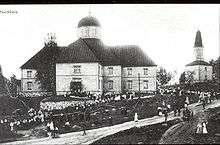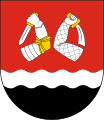Parikkala
Parikkala is a municipality of Finland located in the province of Southern Finland and is part of the South Karelia region. The municipality has a population of 4,840 (31 January 2019)[2] and covers an area of 760.71 square kilometres (293.71 sq mi) of which 167.78 km2 (64.78 sq mi) is water.[1] The population density is 8.16 inhabitants per square kilometre (21.1/sq mi).
Parikkala | |
|---|---|
Municipality | |
| Parikkalan kunta Parikkala kommun | |
Church of Saari | |
 Coat of arms | |
 Location of Parikkala in Finland | |
| Coordinates: 61°33′N 029°30′E | |
| Country | |
| Region | South Karelia |
| Sub-region | Imatra sub-region |
| Charter | 1635 |
| Government | |
| • Municipality manager | Alpo Kosunen |
| Area (2018-01-01)[1] | |
| • Total | 760.71 km2 (293.71 sq mi) |
| • Land | 592.93 km2 (228.93 sq mi) |
| • Water | 167.78 km2 (64.78 sq mi) |
| Area rank | 141st largest in Finland |
| Population (2019-01-31)[2] | |
| • Total | 4,840 |
| • Rank | 173rd largest in Finland |
| • Density | 8.16/km2 (21.1/sq mi) |
| Population by native language | |
| • Finnish | 98.5% (official) |
| • Swedish | 0.1% |
| • Others | 1.4% |
| Population by age | |
| • 0 to 14 | 11.2% |
| • 15 to 64 | 60.5% |
| • 65 or older | 28.3% |
| Time zone | UTC+02:00 (EET) |
| • Summer (DST) | UTC+03:00 (EEST) |
| Municipal tax rate[5] | 18.5% |
| Climate | Dfc |
| Website | www.parikkala.fi |
The municipality is unilingually Finnish.
History
Parikkala is located around lake Simpele and it is a part of a countryside rich with hills and chains of ridges. Settlements and artifacts dated to the Stone Age and Bronze Age have been found in Parikkala. A permanent settlement was established around the 15th century. Many demarcations had a significant impact to Parikkala's development from the Treaty of Nöteborg on August 12, 1323 to peace treaties signed in 1947 with the Soviet Union. After World War II 1/3 (199.3 km²) of Parikkala's area was handed over to the Soviet Union. Orthodoxy has been very influential in this area since the middle ages. Later, Parikkala has become known for its many dairies. Parikkala became independent in the year 1617. In the year 2004 three municipalities (Parikkala, Saari and Uukuniemi) merged to form one municipality called Parikkala.

Education
A comprehensive school, one of the first rural schools in Karelia of Ladoga, was founded 1907. In the year 1910 was first three classed school building built, later on it expanded to consist a gymnasium, hall and kitchen. A Grand piano was provided in the hall of school, and Finnish artists Toivo Kuula and Oskar Merikanto kept their concerts there when visiting Parikkala. Upper secondary school started in the year 1940 and first class graduated in the year 1943. The largest number of pupils was in the 50s, when over 500 pupils attended school there.
Traveling and Routes
Parikkala is located in on the main railway line from Helsinki to Joensuu. A railway station is in the middle of Parikkala village center. Traveling time is about three and half hours from Helsinki, and all passenger trains stop at Parikkala. The city of Imatra is about 60 km south of Parikkala.
Gallery
- Orthodox road cross on the site of a historical orthodox village.
- Lutheran church of Uukuniemi.
 Old Coat of Arms of Parikkala
Old Coat of Arms of Parikkala
References
- "Area of Finnish Municipalities 1.1.2018" (PDF). National Land Survey of Finland. Retrieved 30 January 2018.
- "Suomen virallinen tilasto (SVT): Väestön ennakkotilasto [verkkojulkaisu]. Tammikuu 2019" (in Finnish). Statistics Finland. Retrieved 15 March 2019.
- "Population according to language and the number of foreigners and land area km2 by area as of 31 December 2008". Statistics Finland's PX-Web databases. Statistics Finland. Retrieved 29 March 2009.
- "Population according to age and gender by area as of 31 December 2008". Statistics Finland's PX-Web databases. Statistics Finland. Retrieved 28 April 2009.
- "List of municipal and parish tax rates in 2011". Tax Administration of Finland. 29 November 2010. Retrieved 13 March 2011.
External links

- Municipality of Parikkala
- Beaches
- goSaimaa.com – travel information
- Siikalahti Wetland
- Parikkalan Urheilijat – Athletes Club
- Business Owners of Parikkala
